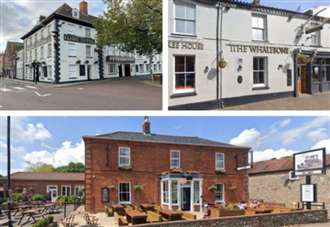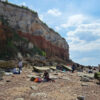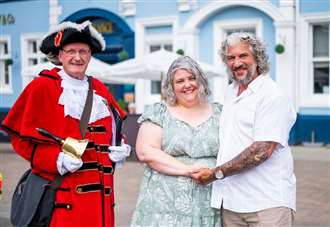-
 play_arrow
play_arrow
KL1 RADIO KL1 Radio Local Radio for West Norfolk
-
 play_arrow
play_arrow
KL DISCO KL Disco Playing Disco Music from the 70's onwards.24/7
-
 play_arrow
play_arrow
KL COUNTRY KL COUNTRY Playing New and Classic Country Music 24/7
-
 play_arrow
play_arrow
KL ROX KL ROX The best of New and Classic Rock.24/7
-
 play_arrow
play_arrow
KL SUMMER Summer Vibes 24/7 from KL1 Radio across West Norfolk
-
 play_arrow
play_arrow
KL CHILL Just Chill!
-
 play_arrow
play_arrow
KL POP The Best POP Hits all day Long!
-
 play_arrow
play_arrow
KL XTRA KL XTRA, The PopUp Station from KL1
music_note

From two merged buildings to a private residence – these are the stories behind Wetherspoon pubs in our area before the chain added them to its portfolio.While a couple of premises have been inns for centuries, another has a different history, but all three of them have interesting tales to tell.This is what we know about the Wetherspoon pubs in the area – scroll down to read about them.
Downham – The Whalebone The Whalebone on Bridge Street in Downham has a long history of being an inn, which was called The Whalebone in the past.The name is thought to have come from a nearby “flourishing” whaling port in Lynn in the early 1700s – it is thought it may have come from a souvenir whalebone being brought back.These licensed premises are a long-standing feature of Bridge Street.
This grade II listed property is made up of two buildings, combined in recent times.The taller one was originally a private residence, built in the early 18th century. The adjoining building is the original pub and was trading as The Whalebone as early as the 1740s.The Whalebone then became The White Hart in the early 1800s, until it closed in the 2010s.
When Wetherspoon took it over and revamped the premises in March 2018, the original name was reinstated.Lynn – The Globe
JD Wetherspoon’s website states that this pub retains the name of the building first recorded as The Globe Inn in 1650.It is thought the name comes from the nearby properties on King Street – including the St George’s Guildhall – and their connections with William Shakespeare.According to the Historic England website, however, The Globe – a Grade II listed building – is a former merchant’s house or town house which dates back to the early 1700s.It was then altered and extended in the 19th and 20th centuries to create a hotel.The official list entry on Historic England’s website states: “The Globe Hotel is thought to have been built as a prominently-sited town house or merchants house built in the early C18, and occupying a corner plot facing onto King Street, close to the spacious and commercially important Tuesday Market Place.“It is not clear when the building became a hotel, or when the ranges added to the rear of the house and facing onto Ferry Street were built, but it may be that the additions would have originally been warehousing associated with the house, and later rebuilt or remodelled to form additional accommodation for what had become an inn or hotel.
“The present Ferry Street range appears to be of C19 date, although the remodelled two-storey building at the west end of the range which now forms part of the hotel premises may survive from an earlier phase of development.“The hotel was first listed in 1951, at which time the interior was recorded as having been completely remodelled. Further alterations took place in the 1960s and again in the early C21 when the present ground floor open-plan arrangement was completed.”Its interesting past has also included when a mummified cat was discovered at The Globe Hotel in 1945 – probably used to scare away mice, and in 1996, the 19th century rear wing of the building was gutted by a fire.In 2009, the hotel – which now included a pub – applied for planning permission for an extension to a decking area of the beer garden.Fakenham – The Limes
This Georgian-style building has had various names, including The Windsor and The Limes/Limes Hotel, and more recently The Garden House.Until the 1970s, the property had been a private residence known as The Limes, advertised as ‘a freehouse’ by 1978.The building was owned by leading local solicitor Robert Cates during the 1870s and 1880s, who passed possession on to fellow solicitor Stephen Pope in the 1890s.It was revealed that the building had been bought by JD Wetherspoon in 2012, before it opened in March 2013.Throughout the pub, there are penny farthing bicycles, which is because one features on the town sign, which JD Wetherspoon says indicates the “importance of cycle manufacture in Fakenham”.
Similar posts
Upcoming shows

Weekend Back Trax
6:00 am - 8:00 am

Kelvin Scott – Weekend Breakfast
8:00 am - 11:00 am

Vicky Green – Classic Hit Lunchtime
11:00 am - 1:00 pm

Darren Furzey – Classic Hit Weekend
1:00 pm - 3:00 pm

Lee Vincent – Classic Hit Saturday
3:00 pm - 6:00 pm
-

Paris Olympics off to a sodden start with a rain-drenched opening ceremony

Three children who died in house fire are ‘missed beyond measure’, parents say

John Hunt says messages of support ‘like a hug’ following family crossbow deaths

Police officer under criminal investigation for assault after airport video

Hunstanton Fossil Hunting Trip – 18th August 2024
Message Us Now!
Copyright The Mediasite UK - 2023.



